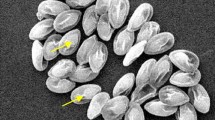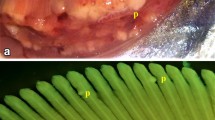Abstract
Severe infections by the protozoan parasite belonging to the genera Myxozoa are causing serious problems in ornamental fish reared in breeding farms. Histopathological study is being used for diagnosis of the severity of diseases. Myxozoan infections result in large scale histopathological damages in different fish tissues. No information is available regarding the histopathological changes of goldfish due to infection with myxozoans. The present study deals with the histopathological changes of the gill, fin, and skin of goldfish, infected with myxozoan parasites along with an ultrastructural study using scanning electron microscope. Several histological alterations have been observed in goldfish, like tissue damage, epithelial hyperplasia, necrosis, anoxia, localized lymphocytic infiltration, excess mucus, cellular necrosis, and epithelial proliferation. The present study revealed the invasion intensified by the occurrence of morphological lesions in the gill, skin, and fin exposed to Myxosporidia, which may lead to respiratory insufficiency in fish and even cause mass mortality.







Similar content being viewed by others
References
Abdel-Ghaffar F, Abdel-Baki AA, EI Garhy M (2005) Ultrastructural characteristics of the sporogenesis of genus Myxobolus infecting some Nile fishes in Egypt. Parasitol Res 95:167–171
Abdel-Ghaffar F, Abdel-Gaber R, Maher S, Al Quraishy S, Mehlhorn H (2016) Morphological re-description and molecular characterization of Kudoa pagrusi (Myxosporea: Multivalvulida) infecting the heart muscles of the common sea bream fish Pagrus pagrus (Perciformes: Sparidae) from the Red Sea, Egypt. Parasitol Res 115:3175–3184
Abdel-Ghaffar F, Morsy K, Bashtar AR, EL-Ganainy S, Gamal S (2013) Thelohanellus niloticus sp. nov. (Myxozoa: Myxosporea), a parasite of the Nile carp Labeo niloticus from the River Nile, Egypt. Parasitol Res 112:379–383
Abdel-Ghaffar F, Morsy K, Mehlhorn H, Bashtar AR, Shazly MA, Saad AH, Abdel-Gaber R (2012) First report of Kudoa species (Myxozoa: Kudoidae) infecting the spotted coral grouper Plectropomus maculates from the Red Sea. A light and ultrastructural study. Parasitol Res 111(4):1579–1585
Abdelsalam M, Abdel-Gaber R, Mahmoud MA, Mahdy OA, Khafaga NIM, Warda M (2015) Morphological, molecular and pathological appraisal of Callitetrarhynchus gracilis plerocerci (Lacistorhynchidae) infecting Atlantic little tunny (Euthynnus alletteratus) in Southeastern Mediterranean. J Adv Res 7(2):317–326
Banerjee S, Dash G, Abraham TJ (2015) Histopathology of gill myxosporean infection in cultured Indian major and minor carps, West Bengal, India. J Appl Ichthyol 1–5 doi: 10.1111/jai.12917
Barot J, Bahadur A (2013) Behavioural and histopathological effects of azodye on kidney and gills of Labeo rohita fingerlings. J Environ Biol 34:147–152
Basu S, Modak BK, Haldar DP (2009) Two new species of Myxobolus Butschli, 1882 (Myxozoa: Myxosporea: Bivalvulida) from food fishes of West Bengal, India—a light and scanning electron microscopy study. Acta Protozool 48:83–89
Bernet D, Schmidt H, Meier W, Burkhardt-Holm P, Wahli T (1999) Histopathology in fish: proposal for a protocol to assess aquatic pollution. J Fish Dis 22:25–34
Butchiram MS, Kumar VM, Tilak KS (2013) Studies on histopathological changes in selected tissues of fish Labeo rohita exposed to phenol. J Env Biol 34:247–251
Camargo MM, Martinez CB (2007) Histopathology of gills, kidney and liver of a neotropical fish caged in an urban stream. Neotrop Ichthyol 5:327–336
Chavda D, Bhatt S, Sreepada RA, Sheth A (2010) Pathogenicity of Myxobolus infection and its effect on protein expression in Catla catla in central Gujarat region. J Cell Tissue Res 10:2157–2164
Chen C, Ma C (1998) Fauna Sinica. Myxozoa, Myxosporea Science Press, Beijing, p 993 (In Chinese)
Das BK, Mukherjee SC, Murjani G (2000) Histopathological studies on the myxoboliasis of Cirrhinus mrigala (Hamilton- Buchanan). Indian J Fish 47:61–64
Dey RK, Kumar D, Mishra BK (1988) Tissue level reaction in the Indian major carp, Catla catla (Ham.) due to Myxobolus sp. infection. Asian Fish Sci 1:117–122
Dykova I, Lom J (1978) Histopathological changes in fish gills infected with myxosporidian parasites of the genus Henneguya. J Fish Biol 12:197–202
Dykova I, Lom J (2007) Histopathology of protistan and myxozoan infections in fishes: an Atlas. Academia, Praha, p 219
Feist SW, Longshaw M (2006) Phylum Myxozoa. In: Woo PTK (ed) Fish diseases and disorders. Protozoan and metazoan infections, 2nd edn. CAB International, Oxfordshire, pp 230–296
Feist SW, Longshaw M (2008) Histopathology of fish parasite infections—importance for populations. J Fish Biol 73:2143–2160
Jha P, Barat S (2005) The effect of stocking density on growth, survival rate, and number of marketable fish produced of koi carps, Cyprinus carpio vr. koi in concrete tanks. J Appl Aquacult 17:89–102
Kalavati C, Nandi NC (2007) Handbook of myxosporidean parasites of Indian fishes. Zoological Society of India, Kolkata, India, p 293
Kalavati C, Narasimhamurti CC (1985) Histopathological changes in the gills of Channa punctatus BL. infected with Henneguya waltairensis. Arch Protistenkd 129:199–202
Kaur H, Katoch A (2014) Gill disease caused by Thelohanellus bifurcata Basu and Haldar, 1999 a pathogenic myxozoan parasite in cultured Indian carp, Labeo rohita (Hamilton, 1822) in Punjab, India. J Anim Health Prod 2:19–24
Kaur H, Singh R (2012) A synopsis of the species of Myxobolus Butschli, 1882 (Myxozoa: Bivalvulida) parasitizing Indian fishes and a revised dichotomous key to myxosporean genera. Syst Parasitol 81:17–37
Kent ML, Andree KB, Bartholomew JL, El-Matboli M, Desser SS, Devlin RH, Feist SW, Hedrick RP, Hoffmann RW, Khattra J, Hallet SL, Lester RJG, Longshaw M, Palenzeula O, Siddall ME, Xiao C (2001) Recent advances in our knowledge of the Myxozoa. J Eukaryot Microbiol 48:395–413
Khalil B (2010) Histopathology of Skin of Some Fishes of Family Sciaenidae from Karachi Coast. Ph.D. thesis Department of Zoology, Jinnah University for Women, Karachi, Pakistan, pp 119–204
Kim WS, Kim JH, Oh MJ (2013) Morphologic and genetic evidence for mixed infection with two Myxobolus species (Myxozoa: Myxobolidae) in gray mullets, Mugil cephalus from Korean waters. Korean J Parasitol 51:369–373
Lightner DV (1993) Diseases of cultured penaeid shrimp. In: McVey JP (ed) CRC Handbook of mariculture: Crustacean aquaculture, 2nd edn. CRC Press Inc, Boca Raton, pp 393–486
Lom J, Arthur JR (1989) A guideline for the preparation of species descriptions in Myxosporea. J Fish Dis 12:151–156
Lom J, Dykova I (2006) Myxozoan genera: definition and notes on taxonomy, life-cycle terminology and pathogenic species. Folia Parasitol 53:1–36
Madhavan R, Bandyopadhyay PK, Santosh B (2013) Observations on the histopathological changes caused by myxosporidian infections in minor carps. J Parasit Dis 37(2):185–188
Marton S, Eszterbauer E (2011) The development of Myxobolus pavlovskii (Myxozoa: Myxobolidae) includes an echinactinomyxon-type actinospore. Folia Parasitol 58:157–163
Molnar K (1979) Gill sphaerosporosis in the common carp and grass carp. Acta Vet Acad Sci Hung 27:99–113
Molnár K, Székely C (2003) Infection in the fins of the goldfish Carassius auratus caused by Myxobolus diversus (Myxosporea). Folia Parasitol 50:31–36
Molnar K (1982) Biology and histopathology of Thelohanellus nikolskii Achmerov, 1955 (Myxosporea, Myxozoa), a protozoan parasite of the common carp (Cyprinus carpio). Z Parasitenkd 68:269–277
Molnar K (2002) Site preference of myxosporeans in the gill. Dis Aquat Org 48:197–207
Morsy K, Abdel-Ghaffar F, Bashtar AR, Mehlhorn H, Al Quraishy S, Abdel-Gaber R (2012) Morphology and small subunit ribosomal DNA sequence of Henneguya suprabranchiae (Myxozoa), a parasite of the catfish Clarias gariepinus (Clariidae) from the River Nile, Egypt. Parasitol Res 111(4):1423–1435
Moyses CRS, Morena DDS, Xavier JG, Antonio AM, Lallo MA (2015) Ectocommensal and ectoparasites in goldfish Carassius auratus (Linnaeus, 1758) in farmed in the state of Sao Paulo. Braz J Vet Parasitol Jaboticabal 24(3):283–289
Pan JH, Zhang JY, Li ZC (1990) Fish Parasitology. Science Press, Beijing, p 443 (In Chinese)
Sanaullah M, Ahmed ATA (1980) Gill myxoboliasis of major carps in Bangladesh. J Fish Dis 3:349–354
Silva SS, Turchini GM (2008) Towards understanding the impacts of the pet food industry on world fish and seafood supplies. J Agric Environ Ethics 21(5):459–467
Singh R, Kaur H (2012) Biodiversity of myxozoan parasites infecting freshwater fishes of three main wetlands of Punjab. India. Protistol 7:79–89
Yokoyama H, Ogawa K, Wakabayashi H (1995) Myxobolus cultus n. sp. (Myxosporea: Myxobolidae) in the goldfish Carassius auratus transformed from the actinosporean stage in the oligochaete Branchiura sowerbyi. J Parasitol 81:446–451
Zhang JY, Gu ZM, Kalavati C, Eiras JC, Liu Y, Guo QY, Molnar K (2013) Synopsis of the species of Thelohanellus Kudo, 1933 (Myxozoa: Myxosporea: Bivalvulida). Syst Parasitol 86:235–256
Zhao Y, Sun C, Kent ML, Deng J, Whipps CM (2008) Description of a new species of Myxobolus (Myxozoa: Myxobolidae) based on morphological and molecular data. J Parasitol 94:737–742
Acknowledgments
One of the authors (MS) is thankful to the University Grants Commission, New Delhi for financial support under Special Assistance Program No. F-3-11/2012(SAP-II). Sincere thanks are also expressed to Dr. Subhadip Bhowmik of University Science Instrumentation Centre, University of Burdwan for his active participation during the SEM study of the tissues.
Author information
Authors and Affiliations
Corresponding author
Ethics declarations
Conflict of interest
The authors declare that they have no conflict of interest.
Rights and permissions
About this article
Cite this article
Saha, M., Bandyopadhyay, P.K. Studies on histopathological alteration of three major organs of the goldfish, Carassius auratus L., of India due to myxozoan infection with special reference to scanning electron microscopic observation. Parasitol Res 116, 511–520 (2017). https://doi.org/10.1007/s00436-016-5314-9
Received:
Accepted:
Published:
Issue Date:
DOI: https://doi.org/10.1007/s00436-016-5314-9




